

Leases On January 1, 2020, Cage Company contracts to lease equipment for 5 years, agreeing to make a payment of $120,987 at the beginning of each year, starting January 1, 2020. The leased equipment is to be capitalized at $550,000. The asset is to be amortized on a double-declining-balance basis, and the obligation is to be reduced on an effective-interest basis. Cage's incremental borrowing rate is 6%, and the implicit rate in the lease is 5%, which is known by Cage. Title to the equipment transfers to Cage at the end of the lease. The asset has an estimated useful life of 5 years and no residual value. Instructions: (a) Prepare the journal entry or entries that Cage should record on January 1, 2020. (Show two separate entries. One for recording the leased asset and one to record the initial payment). (b) Prepare the journal entries to record amortization of the leased asset and interest expense for the year 2020. Include an amortization schedule. (c) Prepare the journal entry to record the lease payment of January 1, 2021, assuming reversing entries are not made. (The assumption referenced in this question means that there was no initial accrual of the interest expense with a corresponding credit to interest payable. Therefore, there would be no reversing entry made at the time of payment (i.e. no debit to interest payable to reverse the accrual). So what accounts would be affected when this journal entry is made assuming these facts?) (d) What amounts will appear on the lessee's December 31, 2020 balance sheet relative to the lease contract? Note about journal entry format: Enter debits first Points may be deducted for incorrect account names. Display whole numbers for journal entries (a) Debit Credit Jan. 1 Right of Use Asset Lease Liability (To record the leased asset.) Jan. 1 120,987 Lease Liability Cash (To record initial payment.) 120,987 (b) Credit Debit 220,000 Dec. 31 Amortization Expense Right of Use Asset (To record amortization.) 220,000 Dec. 31 21,451 Interest Expense Lease Liability (To record interest expense.) 21,451 (c) Debit Credit Jan. 1 2021 Lease Liability Cash (To record lease payment on Jan. 1 2021) AMORTIZATION SCHEDULE You need to use formulas and cell references in the amortization schedule or your numbers may not agree to the grading schedule. Interest (5%) on Liability Reduction of Balance of Lease Liability Lease Liability Date 01/01/20 01/01/20 01/01/21 01/01/22 01/01/23 01/01/24 Annual Lease Payment 550,000 $ 429,013 329,477 224,964 $ 983,454 S $ (d) What amounts will appear on the lessee's balance sheet at December 31, 2020? $ 120,987 Current liabilities: Lease liability Long-term liabilities: Lease liability Non-current assets: Right-of-use asset $ 329,477 Leases On January 1, 2020, Cage Company contracts to lease equipment for 5 years, agreeing to make a payment of $120,987 at the beginning of each year, starting January 1, 2020. The leased equipment is to be capitalized at $550,000. The asset is to be amortized on a double-declining-balance basis, and the obligation is to be reduced on an effective-interest basis. Cage's incremental borrowing rate is 6%, and the implicit rate in the lease is 5%, which is known by Cage. Title to the equipment transfers to Cage at the end of the lease. The asset has an estimated useful life of 5 years and no residual value. Instructions: (a) Prepare the journal entry or entries that Cage should record on January 1, 2020. (Show two separate entries. One for recording the leased asset and one to record the initial payment). (b) Prepare the journal entries to record amortization of the leased asset and interest expense for the year 2020. Include an amortization schedule. (c) Prepare the journal entry to record the lease payment of January 1, 2021, assuming reversing entries are not made. (The assumption referenced in this question means that there was no initial accrual of the interest expense with a corresponding credit to interest payable. Therefore, there would be no reversing entry made at the time of payment (i.e. no debit to interest payable to reverse the accrual). So what accounts would be affected when this journal entry is made assuming these facts?) (d) What amounts will appear on the lessee's December 31, 2020 balance sheet relative to the lease contract? Note about journal entry format: Enter debits first Points may be deducted for incorrect account names. Display whole numbers for journal entries (a) Debit Credit Jan. 1 Right of Use Asset Lease Liability (To record the leased asset.) Jan. 1 120,987 Lease Liability Cash (To record initial payment.) 120,987 (b) Credit Debit 220,000 Dec. 31 Amortization Expense Right of Use Asset (To record amortization.) 220,000 Dec. 31 21,451 Interest Expense Lease Liability (To record interest expense.) 21,451 (c) Debit Credit Jan. 1 2021 Lease Liability Cash (To record lease payment on Jan. 1 2021) AMORTIZATION SCHEDULE You need to use formulas and cell references in the amortization schedule or your numbers may not agree to the grading schedule. Interest (5%) on Liability Reduction of Balance of Lease Liability Lease Liability Date 01/01/20 01/01/20 01/01/21 01/01/22 01/01/23 01/01/24 Annual Lease Payment 550,000 $ 429,013 329,477 224,964 $ 983,454 S $ (d) What amounts will appear on the lessee's balance sheet at December 31, 2020? $ 120,987 Current liabilities: Lease liability Long-term liabilities: Lease liability Non-current assets: Right-of-use asset $ 329,477








